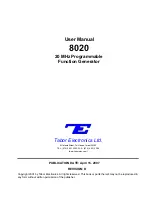
5
Section 1 |
important Safety instructions
the value of the current carried through it. The resistance of the wire is inversely proportional to the
cross-sectional area of the wire (designated in mm
2
or AWG) and directly proportional to its length i.e.
thinner and longer wire has higher resistance and hence, produces higher voltage drop. Similarly, thicker
and shorter wire has lower resistance and hence, produces lower voltage drop. Hence, symptoms of
low DC input voltage / battery power can result from wires that are either excessively long or have an
insufficient cross-sectional area (designated in mm
2
or AWG). the wires should be sized based on (i) the
maximum current they are required to carry based on the temperature rating of their insulation and
(ii) the distance between the battery and the inverter to limit the voltage drop to 2% to 5%. Please
refer to table 4.1 for wire sizing.
Wires are rated based on its insulation, temperature and operating environment. Please ensure that the
wire insulation is of the appropriate type for the operating environment.
The installer/operator should be especially aware of the requirements to maintain secure, tight, water-
resistant electrical connections and to provide for strain relief for DC wires and appliance wiring.
sectIOn 2 |
Design Features and Principle Of Operation
2.1 GeneRAL
The inverter converts low voltage DC (Direct Current) from a battery or other DC power source to the
standard nominal 115 volt AC (Alternating Current) household power.
2.2 DeSIGn FeAtUReS
•
High efficiency
•
Compact size
•
Low Idle current
•
Soft Start Technology
•
LCD remote Control Model SSW-r1-12b (SSW-1000-12A, SSW-1500-12A and SSW-2000-12A only)
•
USb Charging Port, 5V, 500mA (SSW-350-12A and SSW-600-12A only)
2.3 PoWeR RAtInGS
The continuous power ratings of the models are as follows:
•
SSW-350-12A - 350 Watts
•
SSW-600-12A - 600 Watts
•
SSW-1000-12A - 1000 Watts
•
SSW-1500-12A - 1500 Watts
•
SSW-2000-12A - 2000 Watts
2.4 PRIncIPLe oF oPeRAtIon
The inverter converts power in two stages. The first stage is a DC to DC conversion process that raises the
low voltage DC at the inverter input to high voltage DC of approximately 150 VDC. The second stage is
the actual inverter stage that converts the high voltage DC into nominal 115 VAC, 60 Hz AC (rMS). The
DC-to-DC converter stage uses modern high frequency power conversion techniques that have replaced
the bulky transformers found in less technologically-advanced models. The inverter stage uses advanced
power MoSfeT transistors in a high frequency, full bridge configuration.
Summary of Contents for SSW-1000-12A
Page 25: ...NOTES ...






































